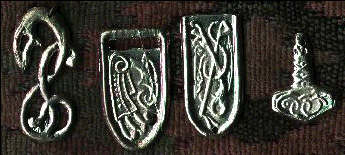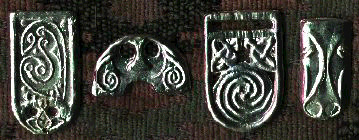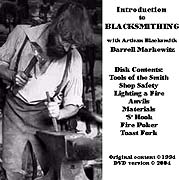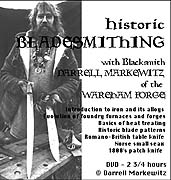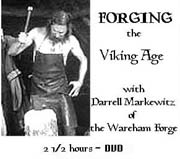- There is a interplay between material, technology and application
throughout history. In our real world, the reason why a specific type
of metal was used for a specific form of armour & weapons can have
to due with more complex factors than 'what is most effective. (My
favourite example is the Trojan War being fought with *bronze* armour
and weapons - although *iron* technologies had been developed at least
1500 years earlier!)
This piece may not necessarily be
insightful to a good number of my regular readers. It maybe does
represent a kind of creative thought experiment however.
I am a private game designer and am
in the middle of writing a game that utilizes different metals for
forging primarily armor and weaponry. I have a compiled list of most
metals and alloys but I'm having extreme difficulty in generating a
'generalized' list of the most common metals / alloys used, and maybe
with a few durable rare ones I'm not aware of, that are used for weapon
and armor forging and what their comparable strengths are when compared
against one another based on damage type received (blunt, slashing etc.)
...
Could you, or would you please, help me to figure out the best types
of metals for armor and weaponry over the others and why they're
better or why they shouldn't be used either for weapon crafting, armor
crafting or both?
Dan
So - your problem (as with all
*game* designs) is the line between the
real world and the ideal in a game universe
First thing I should mention is that the melting points are not
(basically) important here. They may give you some idea of the working
temperatures, but most of the
*functional* metals and alloys are in fact
not cast (melted and poured) but either cold hammered / hot forged.
So here is some basic information for you / I have re-ordered the list
in terms of 'effectiveness' - plus added some stuff you have not
considered. The way the individual materials is worked - or the form of
the armour itself is also an important factor to consider.
'skilled' means a generally useful individual with basic knowledge and tools
'specialist' means a trained individual with specifc tools
'expert' means an experienced artisan with highly specific tools
Listed 'lowest to highest'
ARMOURS
Quilted cloth (non metal)
soft (minimal protection, but cheap and easy)
some resistance to thrust and slash (but minimal at the 'seams') minimal
against crushing
no special tools
Leather (non metal)
soft (minimal protection, but cheap and easy)
some resistance to thrust, better against slash, not good against axes
no special tools
Boiled leather (non metal)
boiled or baked with wax
better resistance to thrust, good against slash, slightly better against
crushing
no special tools
Horn (non metal)
most typically used as scale construction
slightly better resistance to thrust, good against slash, less effective
against crushing
very materials intense to produce
Scale
overlaping pieces of metal (horn, boiled leather) on cloth or leather vest
varies with material used
very good against slash, good against thrust, less effective against
crushing
labour intense to produce
Chain
interlocked rings of metal
1) butted ends
2) rivet closed
3) welded
very good against slash, good against thrust (only fair against arrows),
less effective against crushing
extremely labour intense to produce
extremely fatiguing to wear
Coat of Plates
'vest' of leather or heavy cloth - contains bars or small plates of metal
varies with metal used
bars - very good against slash, not great against thrust, good against
crushing
plates very good against slash, thrust, good against crushing
minimal metal working required
Primary Plate
large pieces cover non moving body areas (chest, thigh, forearm)
varies with metal used
very good against slash, thrust, crushing
skilled metal working required
good balance of protection vs fatigue
Articulated Plate
larger plates over front sides of target areas, moving plates over major
joints (knees & elbows)
usually worn over chain (to protect inside of joints)
excellent against slash, thrust, crushing
specialist metal working, careful fitting
extremely fatiguing to wear
Full Plate
entire body covered with fully moving plates (may include inside of joints)
exceptional against slash, thrust, crushing
expert metalworking, careful fitting
moderately fatiguing to wear.
METALS
Lead and Lead Alloys (pewter)
extremely soft (virtually useless as armour)
almost no resistance to thrust, slash crushing
could be either cast to shape or cold hammered from sheet
widely available
Tin (melts at 232 degrees C)
marginly better than lead (virtually useless as armour)
almost no resistance to thrust, slash crushing
could be either cast to shape or cold hammered from sheet
remote and limited sources, used as an alloy component for bronze
Copper (melts at 1083 degrees C)
soft, but can be slightly work hardened
typically cold hammered to shape (difficult to cast)
possible use for scale, coat of plates
weapons - slashing, crushing
alluvial deposits
skilled working
Silver (melts at 1064 degrees C)
soft, but can be slightly work hardened (varys with alloy)
typically cold hammered to shape, could be cast
high cost against lack of function (never used )
alluvial deposits
Gold (melts at 1064 degrees C)
extremely soft (varys slightly with alloy)
typically cold hammered to shape could be cast
extreme high cost against lack of function (never used)
alluvial deposits
Electrum (gold-silver alloy) (melts at 1064 degrees C)
soft, but can be slightly work hardened (varys with alloy)
typically cold hammered to shape could be cast
high cost against lack of function (never used )
Bronze (copper-tin alloy) (melts at 950-1083 degrees C, depending on the
proportion of tin)
Speculum (high-tin bronze) (melts at 850-950 degrees C, depending on the
proportion of tin)
Tin in this alloy has the effect of lowering the melting point, and
increasing the hard / brittleness of the mixture. So at 15% plus the
alloy casts very easily, but is so brittle it breaks if dropped on a
hard surface. Depending on alloy, the lower tin contents can be
hammered cold. All alloys can be cast, or hot forged.
the advantage to bronze is that it is easily cast into moulds, making
mass production possible
primarily seen as primary plate
weapons based on thrust rather than slash (spears)
specialist working
Stone
depending on stone type, finished blades can be
*extremely* sharp,
problem is that they are also very brittle.
no armour applications
weapons slashing or crushing
skilled working
Iron (melts at 1536 degrees C)
Pure wrought iron is actually
*softer* than a high tin bronze. Wrought
iron is quite flexible, so resists impact damage (sword may bend, but
not break)
Iron ores are everywhere, and althought the production of ore to iron is
difficult, working iron bars into objects is relatively easy.
Iron is hot forged to shape. Armour may have cold hammering to finish
suits all armour types, especially chain, plate
weapons of all types, especially slashing
specialist work to smelt
specialist work to forge
skilled work for basic repairs
Steel (iron-carbon alloy) (melts at 1300-1536 degrees C, depending on
the proportion of carbon)
Small quantities of carbon (typically .2 - 1 %) allow radical changes to
the qualities of the metal via a complex heat treating process. As
carbon increases, so does potential hardness, but also potential
brittleness. Individual alloys best suit specific applications only (.5
carbon for swords, .75 carbon for knives)
The 'case hardening' process bakes a thin layer of higher carbon over
the surface of a softer wrought iron core. This method was often used
for plate armours.
suits all armour types, especially plate types
weapons of all types, especially slashing
Steel is hot forged to shape. Armour may have cold hammering to finish
expert work to smelt
specialist to expert work to forge
skilled work for basic repairs
Layered Steels
The best way to create exceptional weapons (to the advent of modern
exotic alloy steels) was to layer together thin plates of wrought iron
(flexible) and carbon steel (hard). The resulting layered block combines
the primary desired qualities of the two components.
Layered steels are hot forged to shape
weapons - primarily slashing
expert work to forge
specialist to expert work to repair
Note : The sole
*historical* exotic alloy used was nickel iron - sourced
from metallic meteors. Nickel contents typically 7 - 15 %. (For
comparison, your modern table knife is roughly .5 % nickel) Likely you
would place it on this simple chart between Steels and Layered Steels
Note : The iron alloys were never used as a cast material (carbon
content over 1.5 %) for either weapons or armour. Although easy to mass
produce, the metal is brittle -and because of the process extremely heavy.


















